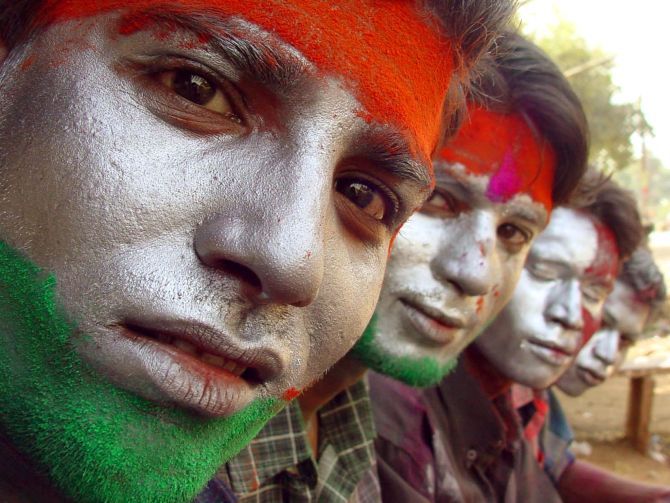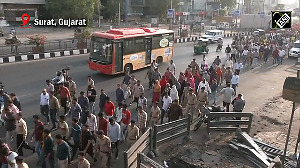The government has announced a number of missions, but one on agriculture isn't in place yet, notes Subir Gokarn As the National Democratic Alliance government approaches its first anniversary, the assessments are already beginning to pour in.
As the National Democratic Alliance government approaches its first anniversary, the assessments are already beginning to pour in.
Typically, they will range from congratulatory to critical, depending on the observer and the criterion. Here is my contribution to the kitty.
A year ago, I had written a column entitled Three national missions, in which I had argued that the three critical structural challenges for the new government were food, infrastructure and employment.
It is only appropriate that my assessment of its first-year performance be based on how it has or hasn't addressed these challenges.
On the food front, the most significant outcome is the moderation of food inflation, which, importantly, has continued despite the disruptions from weather over the past few months.
There are clear policy contributions to this.
The process actually began with one of the last decisions of the United Progressive Alliance government, which was to limit the increase of the minimum support price for rice in the 2014 kharif season to about two per cent, in contrast to the average increase of about 15 per cent during the past five years.
This was followed by the NDA government's decision to keep the rabi MSP increase to the same level.
The other major factor in the moderation was the decision to sell five million tonnes of rice and wheat from the government's stocks, beginning in June 2014.
The impact of this combination of responses was immediate and significant. Rice prices increased by an average rate of about 16 per cent a year between May 2012 and May 2014.
From June 2014 onwards, the rate of increase dropped to about six per cent on an annual rate.
Strikingly, in April 2015, despite the advance crop estimate for wheat suggesting a reduction in output, the increase in consumer prices of cereals was just about two per cent over a year ago.
Stocks can be a very effective instrument of price stabilisation, if used effectively and credibly.
On the negative side, while these short-term responses have worked well, there has been little focus on a long-term strategy to increase productivity and crop diversification.
The MSP containment should contribute to diversification, but there are major challenges yet to be addressed like input subsidies, particularly urea, water and power.
Supply-chain development is nowhere on the radar.
The government has announced a number of missions, which are beginning to define its development strategy, but there isn't a mission for agriculture in place yet.
This could be reinforcing the perceptions of the government being anti-farmer in the context of the intense debate over the amendments to the land acquisition Bill.
On the infrastructure front, the significant move forward was the setting up of the National Infrastructure and Investment Fund, which was announced in the Budget for 2015-16.
This is a mechanism that could potentially address the now unavoidable need to increase public funding for infrastructure without derailing the fiscal consolidation process. The approach is to use the core resources of the fund to borrow funds from the market and use these to increase investment.
However, there are no indications that the mechanism has been operationalised.
The key attribute of the fund, which differentiates this approach from direct ministerial funding of projects, is its mandate and capacity to prioritise between the large number of projects that are stalled.
This needs to be done on a transparent set of criteria, based on maximising the network externalities of projects.
Putting this capacity in place to very quickly begin deploying the resources that the fund has been provided is of the essence.
Virtually all the major initiatives of the government, particularly 'Make in India', are critically dependent on a rapid improvement in the availability and quality of infrastructure.
Surely, infrastructure itself deserves the status of a mission, dealing with all the bottlenecks -- finance, ownership and governance, local stakeholder concerns and so on -- in an integrated fashion.
On the employment issue, which I will now reframe as the livelihoods imperative, the most significant advancement is on financial inclusion.
This is, logically, a two-stage process.
Stage I is the creation of the channel, which is reflected in the opening of bank accounts, on which the Jan Dhan Yojana has apparently achieved virtually saturation coverage.
Stage II is to populate the channel with appropriate products and services.
This is being accomplished with the very important overdraft facility under the Jan Dhan Yojana itself and the recently initiated accident insurance, life insurance and pension schemes.
The overdraft facility has the potential to increase livelihood opportunities for the typical self-employed person.
The other schemes, priced very attractively, will contribute to lifetime livelihood stability.
On the flip side, as attractive as this package is from the consumer viewpoint, since it is being delivered through the banking and insurance sector, its financial viability needs to be made more transparent. Is it the case that it is viable even at the proposed price points?
If not, who pays the difference? If the financial intermediaries are paying it, it is an imposition on the minority shareholders of many of these institutions.
If the government is paying, this is an additional load on an already overburdened fiscal situation.
The distribution of financial responsibility needs to be sorted out for the initiative to realise its full potential.
Other dimensions of the livelihoods strategy include the very significant reform in job security regulations in Rajasthan, which is apparently being followed by some other states, and the "Skill India" mission, which has now been institutionalised as a separate ministry.
Of course, besides self-employment, millions of jobs need to be created, which takes us back to the delicate infrastructure situation.
The insurance and pension schemes referred to earlier are an integral part of a comprehensive safety net, which could be complemented with an urban unemployment insurance framework to complement the rural employment guarantee scheme.
Overall, with reference to the three main structural challenges, there have clearly been significant achievements.
Of course, the enthusiasm around these have to be tempered somewhat by some obvious gaps and incompleteness.
Favourable macroeconomic conditions provide a firm platform for pushing ahead on various fronts.
Significant progress on several parameters creates a tipping point situation for growth acceleration, like we saw in 2003.
Of course, if governments could deal with all their challenges in one year, they wouldn't need five-year terms!
Image: Men wear Tricolour paints on their faces. Photograph: Reuters
Subir Gokarn is director of research, Brookings India, and former deputy governor, RBI. These views are his own







 © 2025
© 2025